Hey, so here are Jeff’s reviews! They have a common thread, I think! Click through to read them with your eyes, or don’t click through to read them with the power of your imagination.
Batman ’66 Meets The Green Hornet #1: No idea why I bought this. No idea at all. I mean, yeah, I actually purchased twenty or so issues of Batman ’66 digitally (which means 7 issues of what they released in print?) and despite the best efforts of Jeff Parker and the artwork that ran the gamut from okay to really goddamn good, I found myself getting a little restless and bored so I jumped ship. I’m not sure if there’s another mainstream writer so willing and able to engage in straight-faced camp as Jeff Parker, but it only worked for so long for me.
And Kevin Smith comics…look, I’m not gonna lie. I bought more of those damn things that I feel comfortable admitting. And I bet some of ‘em will hold up pretty well. (I mean, those Jay & Silent Bob comics were done with Duncan Fegredo—god damn right they’ll hold up well!) But there was a distinct point where I gave up on each stage of the multi-hyphenate’s career—a new limb dropping off the shuffling leper—because it was obvious he was never going to sharpen up as a creator, he was just fine doing what he was doing as long as it was fiscally successful or he could figure out ways to blame other people when it wasn’t.
So I guess with this book I was thinking…I don’t know? There’s a certain amount of “well, I used to like huffing glue, and I used to like visiting hookers who live in backwood trailers so…maybe doing both at the same time will be awesome?” And to be fair, there was the promise of art by Ty Templeton, and a fun-looking cover by Alex Ross… Ralph Garman was co-writing! (Not that that means much to me, I admit, but at least the idea of someone co-writing meant there weren’t going to be overly long monologues that should’ve been cut or, at least, rewritten…)
The first quarter is some seriously slow stuff, with Bruce Wayne preparing to protect a precious artifact being transported via train from Gotham and Dick Grayson preparing for a date. The second quarter is not much better, unless you are seriously into fanservice, as Bruce encounters Britt Reid and Kato on aforementioned train and they banter over a meal. And the last half consists of the train being robbed by a dude with a mask of paste, a pink general’s outfit, and various henchmen in military garb. Robin is summoned, cue the oversized onomatopoeia, and the bad guy reveals himself to be General Gumm, the rebrand-for-copyright-reasons of Colonel-Gumm from the original crossover. Instead of being Harry Mudd in an Orange is the New Black-style jumpsuit, General Gumm is now Baron Zemo with Laugh-In’s color scheme.
(I was reading somewhere on the Internet recently, some creator or somebody (yes, of course, Jeff, “some creator or somebody,” how delightfully specific) talking about how fans shouldn’t fall in love with their own theories so much they get disappointed when the show doesn’t fall in line with it. I’ve got some pretty complicated feelings on the topic—“yes, fans, how dare you be more entertaining than what you watch! Don’t you know your place?” is my initial knee-jerk—but my disappointment that the guy in the absurd military outfit with the super-adhesive powers was not called Benito Glue-ssolini? I guess that’s on me. That’s my fault.)
Looking back on it, I guess it’s obvious I was the wrong audience from the beginning since—cue gasp of disbelief—I’ve never seen the original Batman/Green Hornet crossover. And as much as I want to crab about it, was I really justified in thinking this book might’ve been crafted to appeal to more than just the people sitting in the dead-center of the market audience bullseye? That’s not how comics work, Jeff!
Anyway, this book did give me some new thoughts to chew over about Robin ’66—and maybe I’ll get around to writing something on the subject if I inexplicably pick up another issue—so there is that. But either this was not my thing, or it is not a very good thing. Wish I could nail it down more than that. But I can’t. Woo! Don’t you wish you’d used your powers of imagination now?
Big Trouble In Little China #1: I was on slightly better ground with this one, having seen the original John Carpenter film in the theater and having caught pieces of it on cable over the years. I’m not a huge fan, I admit, but I did pick this up because I thought if there was anyone who could pull the book off it would be Eric Powell, creator of The Goon.
And the first half of the book I quite liked: Powell nails the voice of Jack Burton and, even better, picks up from the end of the actual film so smoothly it’s practically elegant. Really, I don’t know if it was a resolution John Carpenter, who shares story credit here, had figured out way back when, or if Powell put it together on his own but it does a great job at resolving a cliffhanger, and then launching things into a riff on (at the very least) the Clint Eastwood films Every Which Way But Loose and Any Which Way You Can, as well as providing another guardian for the hapless, big-talking Jack Burton.
The second half, though, works less well, as Jack returns in time for Wang’s wedding and a new villain who sends Jack on a quest to retrieve the three eggs of something-or-other. Artist Brian Churilla draws a fantastic Egg Shen (because if there’s anyone who looks like a human cartoon, it’s actor Victor Wong) but it’s exactly in the jam-packed wedding scenes that the gambit of using a looser style like his falls through.
I know comics licensed from shows and movies are hell on artists—to paraphrase the joke about special effects, there’s: (a) fidelity to actors’ likenesses; (b) fluidity of action; and (c) timely turnaround, and an editor can choose any two out of the three they want—and depending on the licensor, approval can put a bottleneck the scheduling, but there’s a good case to be made that if any comics adaptation should go down the realistic-but-stiff road, it’s Big Trouble in Little China. It’s a movie of struck poses, practical effects, guys shoved into uncomfortable costumes—hell, I’d go so far as to say the triumph of James Hong as Lo Pan is precisely how he uses rigidity to convey incredible power in captivity—heightened by the way Carpenter uses this rigidity to keep the viewer off-balance as to how much of the movie should be taken seriously or not. I mean, this may be something that’s easy to forget if you’ve seen the movie a lot, but BTiLC is a weird-ass movie the first time through, with scenes of the uncanny jostling aside the camp, and the camp shoving its way back into frame five minutes later. Churilla and colorist Michael Garland give us something lively and fun, but when the forces of darkness attack, it is utterly flyweight and heightens the perfunctory feeling of the climax.
Considering “perfunctory” is the exact antithesis of what the movie feels like the first time you watch it, I guess it’s not a surprise I put down the first issue feeling a bit lukewarm on the endeavor. I’ll keep an eye peeled for future issues in the hope the team gets a chance to hit new territory but, depending on its length and how much familiar territory it re-treads, the first story may keep me from ever getting that far.
That’s Because You’re A Robot One-Shot: A very funny book by writer David Quantick and artist provocateur Shaky Kane, That’s Because You’re A Robot will flip you back and forth so quickly and repeatedly between feeling like you’re reading a one-joke one shot and a complex and mysteriously multi-joke one shot that you’ll feel like a quantum particle bouncing between orbits. It helps that the one joke—one member of a pair of cops is a robot, but neither of them knows which one it is—is very well done. Throughout the book, cops Jeff and Matt detour every conversation into a way to insinuate the other is a robot or to deflect their own suspicions they themselves are the robot. Although Quantick has written for a number of British shows like Brass Eye and The Thick Of It, the gamut of jokes actually reminds me of a more leisurely version of the “You know how I know you’re gay?” routine from The 40 Year Old Virgin. Although part of the comedy comes from the ridiculousness of what each cop says (“How can I be a robot? I’m Jewish!”), the real joke is that, just as someone being gay is no longer so widely feared, being a robot without knowing it is no longer a source of Phildickian self-doubt: it’s just one more thing your friends are going to bust your balls over.
That’s the one joke. The quantum flipping about comes from, unsurprisingly, Shaky Kane’s joyously non-naturalistic art and the way it is either suffusing or stripping the material of meaning. On the one hand, this is absolutely the way Shaky Kane draws (at least in my limited experience): with gleefully Panteresque landscapes inhabited by decaying icons of a previous generation’s pop culture. In the background of Matt and Jeff’s world, Frankenstein’s Monster, a ghost armed with toy guns, and a leering evil leprechaun among others run amok, and by the end of the book the two cops are not only no closer to figuring out which of them is the robot, they are no closer to figuring out the conspiracy in which they’ve become enmeshed, only that it appears to suffuse every level of their world.
So is the book’s second joke that everything in the book is a robot, something fictional that if it really had sentience could only feel the force of it laboring under the creator’s intentions? (Sorry for the mawkishness–I was trying to work in something about the Czech roots of the word “robot” as “forced labor”,” or is the second joke that this is the only way you can craft a meaning out of the obsessions of Mr. Kane?
Either way, it’s a pretty good joke, and either way you get a two-jokes book for the price of a one-joke book! In a way, I wish it had been $2.99 instead of $3.99, but I guess I also wish the creators will actually see some money from this so…let’s just pretend I didn’t write this last sentence, right?
D4VE issues #1-5: This Monkeybrain book from writer Ryan Ferrier and Valentin Ramon is digital only, so if you have no enjoyable way to read digital comics, feel free to skip over this review (even more than your sensible inclination to skip over everything else I’ve had to say so far, of course).
But if you do read digital comics? Regardless of everything else that is about to tumble out of my WordPresshole, consider picking up at least the first issue of this because the art and coloring by Valentin Ramon is just sumptuous. In fact, you can buy all five issues of D4VE off Comixology, and get well over three times the page count of Uncanny X-Men Special #1 for four cents less. Seriously, if you liked, I dunno, any of the lighter and brighter looking stuff that’s run in Judge Dredd Megazine lately (I’m thinking the coloring D’Israeli did on Ordinary or Michael Dowling’s on Judge Anderson), Ramon’s work is just a step or two below that: the work inside doesn’t pop quite as gorgeously as it does on the covers, but it still manages to give the linework a weight or lightness as needed.
And despite the crabbiness I keep promising to deliver, this is a funny book I found funny. Ryan Ferrier’s tale of D4Ve, a combat robot lost and forlorn in the post-human suburbia of robot Earth, has a nice hook: when aliens make contact with a robot race that’s forgotten how to fight, it’s unclear for a bit whether D4VE’s craving for his good old days will doom his people or save them. The script is filled with light, pithy dialogue (“Even FISH3R, the speak’n’spell in the mailroom, is hitting more deadlines than you.”), a ton of running jokes, and gives a lot of great visual set-ups for Valentin to thoroughly deliver on. I can’t decide whether D4VE could be a potty-mouthed Pixar movie, or a Futurama episode written with a South Park sensibility…but both of those sound pretty okay, right?
Again, it’s not bad at all. But at some point in second issue of D4VE, I had to downgrade my expectations from “great” to “really good,” and I continued to downshift my expectations from there.
For one thing, it goes on too long. I think I can understand why: at 90+pages, D4VE will look like a respectable-sized trade if it gets into print, which gives it a better chance at actually ending up in print. And, frankly, if I had Ramon Valentin drawing a story of mine, I’d drag that sonuvabitch out as long as I could because his work, as mentioned, is beautiful.
But there’s a reason people say comedies are better when they’re short…and that’s because they are. D4VE hits a lot of the same notes over and over. Worse, there are five other characters in the story, three of which we’re supposed to care about at least a little bit, and only one of them—5COTTY, D4VE’s recently ordered and installed teenage son—has any resonance at all. D4VE’s estranged wife is the flattest of flat characters, which means her sister TIN4 is practically concave by comparison.
Comedy is the perfect place for flat characters, of course, but that means unoriginal scenes of them talking about their problems grinds things to a halt even faster than they would otherwise. By the time the book hits its last issue, it feels like it’s only really begun to get started. If some savvy producer does come across this material and snaps it up to put into development—and believe me, they could do much, much worse—there’s going to be a lot of rewriting to make that last act mean anything. I sooo wanted to wholeheartedly recommend this book and it breaks my heart a little bit that I can’t.
Sexcastle OGN: Whereas this bad boy I’m really going to encourage you to hunt up when it comes out: I normally don’t end up near enough to the bleeding edge to be reviewing a copy of a Digital OGN that has thus far only been released to the book’s Kickstartees, but someone I trust on Twitter recommended it and it looked worth a shot so I backed it at the “get a PDF” level.
What I got was worth that shot, as well as several rounds of very solid return fire. Kyle Starks’ story of Shane Sexcastle, “former Worlds Greatest Hitman
turned former Secret Service agent turned former convict,” trying to start a new life, is an over-the-top parody of every over-the-top movie in the “tough guy can’t escape from his old life of ass-kicking” genre. The hero’s eyepatch, the “Final Nine” henchmen hired to take out Sexcastle, and the final action scene revolving around a helicopter—sorry, I know there’s a killer pun in a sentence where “revolving” and “helicopter” is concerned but I just can’t parse it out at the moment—all are signifiers for ‘80s movies, but the tropes of the story also call back to early ‘70s stalwarts like Billy Jack or Bruce Lee’s The Big Boss (which was called Fists of Fury when I saw it on the big screen at entirely too young an age) and undoubtedly farther.
Sexcastle not only takes D4VE’s propensity for potty-talk and jams a cherry bomb down it (which is to say, it somehow manages to have even more profanity), it manages to be almost twice D4VE’s length while remaining 100% filler-free. Part of that is Starks being able to craft the story exactly as long as he needs without chasing the monthly page-count dragon (hey, I sense a callback to Big Trouble in Little China coming up) and part of that is, without having to worry about the likenesses of actors or sets (yup, there it is), Starks can take his cartooning to its most expressive.
As a result, the funny scenes feel funnier but, even better, the action scenes can go so far over the top they truly become bad-ass. Also, Sexcastle has some genuinely melancholic undertones in its handling of a man who only knows how to kill, and in that way, the book is like a perfect marriage of all the great stuff the Cannons brought to their Double Barrel anthology. Sexcastle is one of those rare books where when I checked my remaining pagecount, I was excited I had so much more to read. Don’t know when it’ll be out, but when it is you should check it out. Recommended.
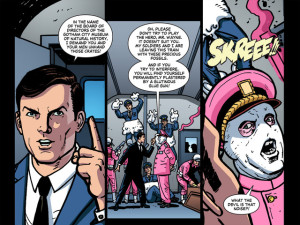
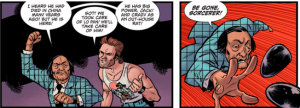
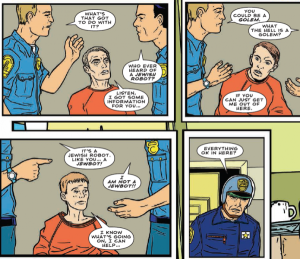
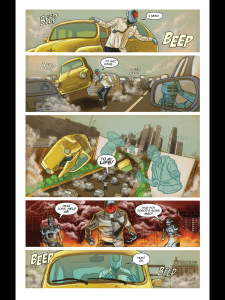
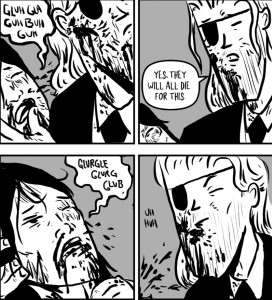


WOW, Jeff, your commitment to that Benito Glue-ssolini joke knocked my socks off. Bravo.
Thanks, Cass. Comments on this post are pretty bare so–yeah, I may have made people do too much work for that one. Glad you dug it, though!
A lot of nostalgia on this reading list. Seems like a send-up will fare better than a tribute critically; there’s just more to say about a send-up. I wonder what’s better for sales though, the pure nostalgia of Batman/GH and Big Trouble in Little China or the referential, but original creations of D4VE, Sexcastle, and That’s Because You’re a Robot.
Not that this is the most constructive criticism of Big Trouble in Little China, but the comic was a lot like a bag of flaming dog shit.